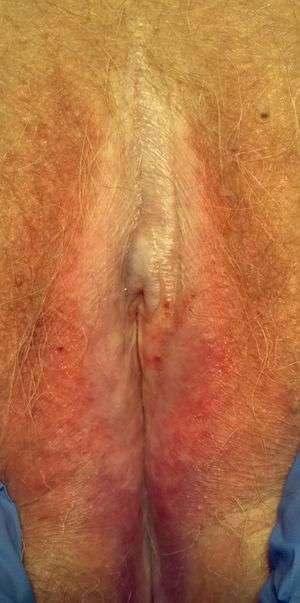Lichen sclerosus
Background
- A benign, chronic, progressive dermatologic condition characterized by marked inflammation, epithelial thinning, and distinctive dermal changes accompanied by symptoms of pruritus and pain
- Typically affects postmenopausal women, however it does sometimes occur in men, children, and premenopausal women
- Thought to be related to low estrogen states
Clinical Features

Lichen sclerosus showing an ivory white coloring in the vulva, and also stretching downward to the perineum.
- Skin becomes thin, wrinkles, and whitened
- In males, most commonly affects glans or foreskin[1]
- Most common symptoms include itching and pain at the affected areas, most commonly the clitoris and labia (although any skin surface can be affected)
- Other symptoms include anal discomfort, dyspareunia, and dysuria
Differential Diagnosis
- Candidiasis
- Lichen planus
- Psoriasis
- Dermatitis
Evaluation
- Biopsy — A vulvar punch biopsy is taken to demonstrate atypical cell histology
- Histopathology — Epidermis is thinned, areas of hyperkeratosis may be observed. Early lesions may show irregular epidermal acanthosis
- Clinical judgment should guide the diagnosis and treatment of LS when biopsy results are not specific
Management
- Behavioral changes: good hygiene, avoid scratching area
- topical steroids such as clobetasol proprionate
Disposition
- Can be chronic
- Increases chance of vulvar squamous cell carcinoma
See Also
External Links
References
- Teichman JM et al. Noninfectious Penile Lesions. Am Fam Physician. 2010 Jan 15;81(2):167-174.
This article is issued from
Wikem.
The text is licensed under Creative
Commons - Attribution - Sharealike.
Additional terms may apply for the media files.